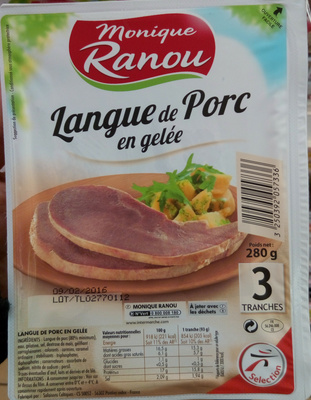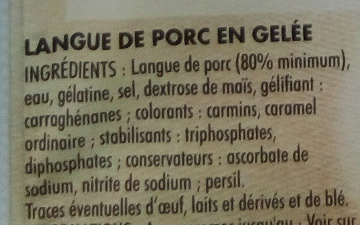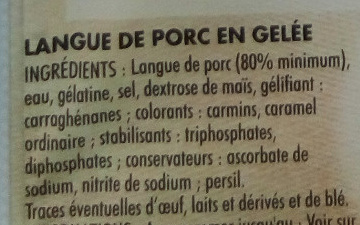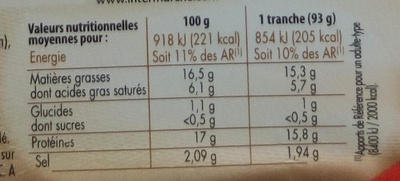Help us make food transparency the norm!
As a non-profit organization, we depend on your donations to continue informing consumers around the world about what they eat.
The food revolution starts with you!
Langue de Porc en gelée - Monique ranou - 280 g
Langue de Porc en gelée - Monique ranou - 280 g
This product page is not complete. You can help to complete it by editing it and adding more data from the photos we have, or by taking more photos using the app for Android or iPhone/iPad. Thank you!
×
Some of the data for this product has been provided directly by the manufacturer .
Barcode: 3250392057336 (EAN / EAN-13)
Quantity: 280 g
Packaging: Plastic, Film, Protective gas, Tray
Brands: Monique ranou
Categories: Meats and their products, Meats, Pork and its products, Pork, Pork tongue
Labels, certifications, awards:
Distributor labels, French meat, French pork, Green Dot, Nutriscore, Nutriscore Grade D
Traceability code: FR 56.246.008 CE - Sourn (Morbihan, France)
Stores: Intermarché
Countries where sold: France
Matching with your preferences
Health
Ingredients
-
17 ingredients
pork tongue (80% minimum), water, gelatin, salt, corn dextrose, gelling agent: carrageenan, colours: carmines, plain caramel, stabilizers: triphosphates, diphosphates, preservatives: sodium ascorbate, sodium nitrite, parsleyTraces: Eggs, Gluten, Milk
Food processing
-
Ultra processed foods
Elements that indicate the product is in the 4 - Ultra processed food and drink products group:
- Additive: E120 - Cochineal
- Additive: E150a - Plain caramel
- Additive: E407 - Carrageenan
- Additive: E428 - Gelatine
- Additive: E450 - Diphosphates
- Additive: E451 - Triphosphates
- Ingredient: Colour
- Ingredient: Dextrose
- Ingredient: Gelling agent
- Ingredient: Glucose
Food products are classified into 4 groups according to their degree of processing:
- Unprocessed or minimally processed foods
- Processed culinary ingredients
- Processed foods
- Ultra processed foods
The determination of the group is based on the category of the product and on the ingredients it contains.
Additives
-
E120 - Cochineal
Carminic acid: Carminic acid -C22H20O13- is a red glucosidal hydroxyanthrapurin that occurs naturally in some scale insects, such as the cochineal, Armenian cochineal, and Polish cochineal. The insects produce the acid as a deterrent to predators. An aluminum salt of carminic acid is the coloring agent in carmine. Synonyms are C.I. 75470 and C.I. Natural Red 4. The chemical structure of carminic acid consists of a core anthraquinone structure linked to a glucose sugar unit. Carminic acid was first synthesized in the laboratory by organic chemists in 1991.Source: Wikipedia
-
E250 - Sodium nitrite
Sodium nitrite: Sodium nitrite is the inorganic compound with the chemical formula NaNO2. It is a white to slightly yellowish crystalline powder that is very soluble in water and is hygroscopic. It is a useful precursor to a variety of organic compounds, such as pharmaceuticals, dyes, and pesticides, but it is probably best known as a food additive to prevent botulism. It is on the World Health Organization's List of Essential Medicines, the most important medications needed in a basic health system.Nitrate or nitrite -ingested- under conditions that result in endogenous nitrosation has been classified as "probably carcinogenic to humans" by International Agency for Research on Cancer -IARC-.Source: Wikipedia
-
E301 - Sodium ascorbate
Sodium ascorbate: Sodium ascorbate is one of a number of mineral salts of ascorbic acid -vitamin C-. The molecular formula of this chemical compound is C6H7NaO6. As the sodium salt of ascorbic acid, it is known as a mineral ascorbate. It has not been demonstrated to be more bioavailable than any other form of vitamin C supplement.Sodium ascorbate normally provides 131 mg of sodium per 1‚000 mg of ascorbic acid -1‚000 mg of sodium ascorbate contains 889 mg of ascorbic acid and 111 mg of sodium-. As a food additive, it has the E number E301 and is used as an antioxidant and an acidity regulator. It is approved for use as a food additive in the EU, USA, and Australia and New Zealand.In in vitro studies, sodium ascorbate has been found to produce cytotoxic effects in various malignant cell lines, which include melanoma cells that are particularly susceptible.Source: Wikipedia
-
E407 - Carrageenan
Carrageenan (E407), derived from red seaweed, is widely employed in the food industry as a gelling, thickening, and stabilizing agent, notably in dairy and meat products.
It can exist in various forms, each imparting distinct textural properties to food.
However, its degraded form, often referred to as poligeenan, has raised health concerns due to its potential inflammatory effects and its classification as a possible human carcinogen (Group 2B) by the International Agency for Research on Cancer (IARC).
Nevertheless, food-grade carrageenan has been deemed safe by various regulatory bodies when consumed in amounts typically found in food.
-
E450 - Diphosphates
Diphosphates (E450) are food additives often utilized to modify the texture of products, acting as leavening agents in baking and preventing the coagulation of canned food.
These salts can stabilize whipped cream and are also found in powdered products to maintain their flow properties. They are commonly present in baked goods, processed meats, and soft drinks.
Derived from phosphoric acid, they're part of our daily phosphate intake, which often surpasses recommended levels due to the prevalence of phosphates in processed foods and drinks.
Excessive phosphate consumption is linked to health issues, such as impaired kidney function and weakened bone health. Though diphosphates are generally regarded as safe when consumed within established acceptable daily intakes, it's imperative to monitor overall phosphate consumption to maintain optimal health.
-
E451 - Triphosphates
Sodium triphosphate: Sodium triphosphate -STP-, also sodium tripolyphosphate -STPP-, or tripolyphosphate -TPP-,- is an inorganic compound with formula Na5P3O10. It is the sodium salt of the polyphosphate penta-anion, which is the conjugate base of triphosphoric acid. It is produced on a large scale as a component of many domestic and industrial products, especially detergents. Environmental problems associated with eutrophication are attributed to its widespread use.Source: Wikipedia
Ingredients analysis
-
Palm oil free
No ingredients containing palm oil detected
-
Non-vegan
Non-vegan ingredients: Pork tongue, E428, E120
-
Non-vegetarian
Non-vegetarian ingredients: Pork tongue, E428, E120
-
Details of the analysis of the ingredients
: Langue de porc 80%, eau, gélatine, sel, dextrose de maïs, gélifiant (carraghénanes), colorants (carmins), caramel ordinaire, stabilisants (triphosphates), diphosphates, conservateurs (ascorbate de sodium), nitrite de sodium, persil- Langue de porc -> en:pork-tongue - vegan: no - vegetarian: no - ciqual_food_code: 40205 - percent_min: 80 - percent: 80 - percent_max: 80
- eau -> en:water - vegan: yes - vegetarian: yes - ciqual_food_code: 18066 - percent_min: 1.66666666666667 - percent_max: 20
- gélatine -> en:e428 - vegan: no - vegetarian: no - percent_min: 0 - percent_max: 18.3333333333333
- sel -> en:salt - vegan: yes - vegetarian: yes - ciqual_food_code: 11058 - percent_min: 0 - percent_max: 2.3
- dextrose de maïs -> en:corn-dextrose - vegan: yes - vegetarian: yes - ciqual_proxy_food_code: 31016 - percent_min: 0 - percent_max: 2.3
- gélifiant -> en:gelling-agent - percent_min: 0 - percent_max: 2.3
- carraghénanes -> en:e407 - vegan: yes - vegetarian: yes - percent_min: 0 - percent_max: 2.3
- colorants -> en:colour - percent_min: 0 - percent_max: 2.3
- carmins -> en:e120 - vegan: no - vegetarian: no - percent_min: 0 - percent_max: 2.3
- caramel ordinaire -> en:e150a - vegan: yes - vegetarian: yes - percent_min: 0 - percent_max: 2.3
- stabilisants -> en:stabiliser - percent_min: 0 - percent_max: 2.3
- triphosphates -> en:e451 - vegan: yes - vegetarian: yes - percent_min: 0 - percent_max: 2.3
- diphosphates -> en:e450 - vegan: yes - vegetarian: yes - percent_min: 0 - percent_max: 2.3
- conservateurs -> en:preservative - percent_min: 0 - percent_max: 2.03703703703704
- ascorbate de sodium -> en:e301 - vegan: yes - vegetarian: yes - percent_min: 0 - percent_max: 2.03703703703704
- nitrite de sodium -> en:e250 - vegan: yes - vegetarian: yes - percent_min: 0 - percent_max: 1.83333333333333
- persil -> en:parsley - vegan: yes - vegetarian: yes - ciqual_proxy_food_code: 11014 - percent_min: 0 - percent_max: 1.66666666666667
en:meat -> en:meat
en:pork -> en:pork
Nutrition
-
Poor nutritional quality
⚠ ️Warning: the amount of fiber is not specified, their possible positive contribution to the grade could not be taken into account.⚠ ️Warning: the amount of fruits, vegetables and nuts is not specified on the label, it was estimated from the list of ingredients: 0This product is not considered a beverage for the calculation of the Nutri-Score.
Positive points: 0
- Proteins: 5 / 5 (value: 18.5, rounded value: 18.5)
- Fiber: 0 / 5 (value: 0, rounded value: 0)
- Fruits, vegetables, nuts, and colza/walnut/olive oils: 0 / 5 (value: 0.0178385416666629, rounded value: 0)
Negative points: 17
- Energy: 2 / 10 (value: 929, rounded value: 929)
- Sugars: 0 / 10 (value: 0.5, rounded value: 0.5)
- Saturated fat: 5 / 10 (value: 5.8, rounded value: 5.8)
- Sodium: 10 / 10 (value: 920, rounded value: 920)
The points for proteins are not counted because the negative points are greater or equal to 11.
Nutritional score: (17 - 0)
Nutri-Score:
-
Nutrient levels
-
Fat in moderate quantity (16.2%)
What you need to know- A high consumption of fat, especially saturated fats, can raise cholesterol, which increases the risk of heart diseases.
Recommendation: Limit the consumption of fat and saturated fat- Choose products with lower fat and saturated fat content.
-
Saturated fat in high quantity (5.8%)
What you need to know- A high consumption of fat, especially saturated fats, can raise cholesterol, which increases the risk of heart diseases.
Recommendation: Limit the consumption of fat and saturated fat- Choose products with lower fat and saturated fat content.
-
Sugars in low quantity (0.5%)
What you need to know- A high consumption of sugar can cause weight gain and tooth decay. It also augments the risk of type 2 diabetes and cardio-vascular diseases.
Recommendation: Limit the consumption of sugar and sugary drinks- Sugary drinks (such as sodas, fruit beverages, and fruit juices and nectars) should be limited as much as possible (no more than 1 glass a day).
- Choose products with lower sugar content and reduce the consumption of products with added sugars.
-
Salt in high quantity (2.3%)
What you need to know- A high consumption of salt (or sodium) can cause raised blood pressure, which can increase the risk of heart disease and stroke.
- Many people who have high blood pressure do not know it, as there are often no symptoms.
- Most people consume too much salt (on average 9 to 12 grams per day), around twice the recommended maximum level of intake.
Recommendation: Limit the consumption of salt and salted food- Reduce the quantity of salt used when cooking, and don't salt again at the table.
- Limit the consumption of salty snacks and choose products with lower salt content.
-
-
Nutrition facts
Nutrition facts As sold
for 100 g / 100 mlAs sold
per serving (Une tranche (93 g))Compared to: Pork tongue Energy 929 kj
(222 kcal)864 kj
(206 kcal)+8% Fat 16.2 g 15.1 g +15% Saturated fat 5.8 g 5.39 g +26% Carbohydrates 0.6 g 0.558 g -1% Sugars 0.5 g 0.465 g +47% Fiber ? ? Proteins 18.5 g 17.2 g +5% Salt 2.3 g 2.14 g +20% Fruits‚ vegetables‚ nuts and rapeseed‚ walnut and olive oils (estimate from ingredients list analysis) 0.018 % 0.018 % Carbon footprint from meat or fish 592 g 551 g
Environment
-
Eco-Score A - Very low environmental impact
⚠ ️Select a country in order to include the full impact of transportation.The Eco-Score is an experimental score that summarizes the environmental impacts of food products.→ The Eco-Score was initially developped for France and it is being extended to other European countries. The Eco-Score formula is subject to change as it is regularly improved to make it more precise and better suited to each country.Life cycle analysis
-
Average impact of products of the same category: A (Score: 80/100)
Category: Tongue, pork, raw
Category: Tongue, pork, raw
- PEF environmental score: 0.28 (the lower the score, the lower the impact)
- including impact on climate change: 2.10 kg CO2 eq/kg of product
Stage Impact Agriculture
73.8 %Processing
10.1 %Packaging
6.5 %Transportation
5.5 %Distribution
3.3 %Consumption
0.9 %
Bonuses and maluses
-
Origins of ingredients with a medium impact
Bonus: +2
Environmental policy: +2
Transportation: 0
Origin of the product and/or its ingredients % of ingredients Impact France 80 %Medium Unknown 20 %High
-
Packaging with a low impact
Malus: -2
Shape Material Recycling Impact 1 Film PE 7 - Polyethylene High 1 Film PVC 3 - Polyvinyl chloride High
Eco-Score for this product
-
Impact for this product: A (Score: 80/100)
Product: Langue de Porc en gelée - Monique ranou - 280 g
Life cycle analysis score: 80
Sum of bonuses and maluses: 0
Final score: 80/100
-
Carbon footprint
-
Equal to driving 1.1 km in a petrol car
210 g CO² per 100g of product
The carbon emission figure comes from ADEME's Agribalyse database, for the category: Tongue, pork, raw (Source: ADEME Agribalyse Database)
Stage Impact Agriculture
70.6 %Processing
4.9 %Packaging
13.1 %Transportation
9.2 %Distribution
1.8 %Consumption
0.3 %
Packaging
-
Packaging with a low impact
-
Packaging parts
1 x Film (PE 7 - Polyethylene: 1.652 g)
1 x Film (PVC 3 - Polyvinyl chloride: 7.58 g)
-
Packaging materials
Material % Packaging weight Packaging weight per 100 g of product Plastic 100% 9.232 g 3.3 g
-
Transportation
-
Origins of ingredients
Origins of ingredients with a medium impact
Origin of the product and/or its ingredients % of ingredients Impact France 80 %Medium Unknown 20 %High
Report a problem
-
Incomplete or incorrect information?
Category, labels, ingredients, allergens, nutritional information, photos etc.
If the information does not match the information on the packaging, please complete or correct it. Open Food Facts is a collaborative database, and every contribution is useful for all.
Data sources
Product added on by sebleouf
Last edit of product page on by inf.
Product page also edited by ecoscore-impact-estimator, kiliweb, openfoodfacts-contributors, org-les-mousquetaires, packbot, roboto-app, segundo, spotter, yuka.UW9rNkM1OEYvT1JhcGZJTXdTdnhwb3g1NGNHUFpWUHFGc2RPSUE9PQ.











